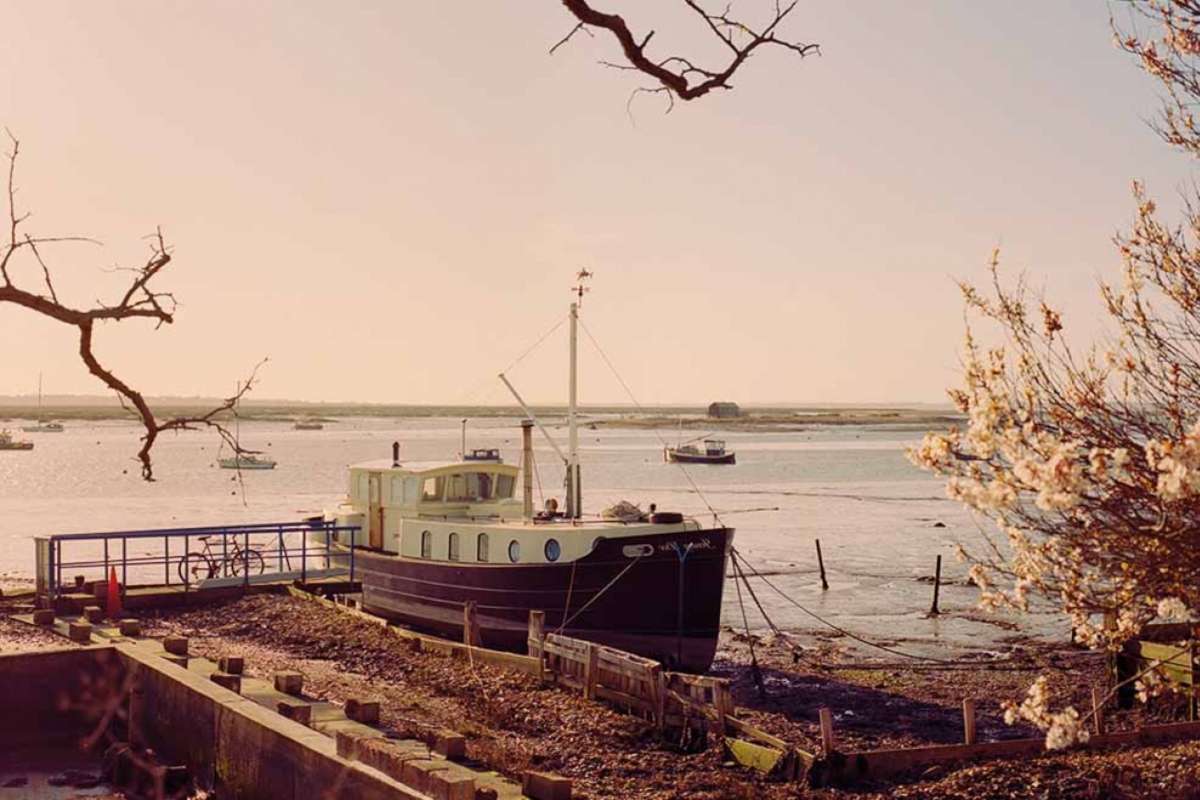
An ambitious oyster reef restoration project in Essex waters could allow oysters to perform their important role in our ecosystems once more
By
Listen to this story on The Geographical Podcast along with expert commentary about how the industrialisation of fishing has impacted marine ecosystems.
Perhaps it’s something primordial, the unmistakable taste of the oyster. That rush of flavour has matured through the tangled web of oceanic life. Anthropologists who subscribe to the ‘aquatic ape’ theory of human evolution believe that our fascination with shellfish stems from a reliance on omega-3 fatty acids, iodine and zinc – nutrients that quickened the cerebral development of modern humans. In South Africa’s Pinnacle Point cave, where the earliest artifacts of Homo sapiens have been found, lies evidence that about 150,000 years ago, our ancestors shifted from a terrestrial diet to the fish and shellfish of the coast. Perhaps, then, the oyster’s flavour is a reminder of our ancient dependency on the sea.
Today, they’re being dispatched off the side of a boat at West Mersea, in the Blackwater Estuary in Essex. The waters are still, save for the metronomic splash of shallow waves against the hull. The shrieks of black-headed gulls fill the air, terns swooping to evade their wingbeats overhead. On the deck, the arm of a JCB thrusts into a pile of shells, scooping up tonnes of oysters, scallops and mussels. Tossed overboard, this material plunges downward, coarse shells scuffing together as they descend.
Since 2011, oyster fishermen, NGOs, marine ecologists and government conservation bodies have joined forces under the Essex Native Oyster Restoration Initiative (ENORI) with the aim of restoring living oyster reefs to Essex waters. So far, they have dropped tens of thousands of mature oysters, along with hundreds of tonnes of empty shells to serve as a settlement substrate, into an experimental restoration plot that forms part of a 284-square-kilometre marine conservation zone – one of the UK’s largest inshore protected areas.
Oyster reefs, crawling with life
Scrawled on the mottled pages of historic fishing logs are descriptions of oyster reefs extending tens of kilometres off the shore. The catches recorded in those logs would only have been possible if oysters existed in incredible densities on the UK’s oyster reefs and descriptions of ‘living crusts of shellfish’ and ‘clumps of oysters in the dredges’ attest to this reality.
One fisherman, James Bertram, wrote of the pre-1840 waters: ‘Then oysters were very plentiful – so plentiful, in fact, that three men in a boat could, with ease, procure 3,000 oysters in a couple of hours.’ Market trading reports log annual sales of more than 700 million native oysters in London markets during the 1860s and by 1875, England had more than 15,000 boats and 50,000 people employed by the oyster industry.
However, as fishing capacity grew to meet London’s demands, the health of the reefs began to suffer. Declining catches meant higher prices and a once-abundant sustenance food was elevated to delicacy status. By 1948, landings of the UK’s fleet dropped to seven million oysters, down from 26 million in 1918.
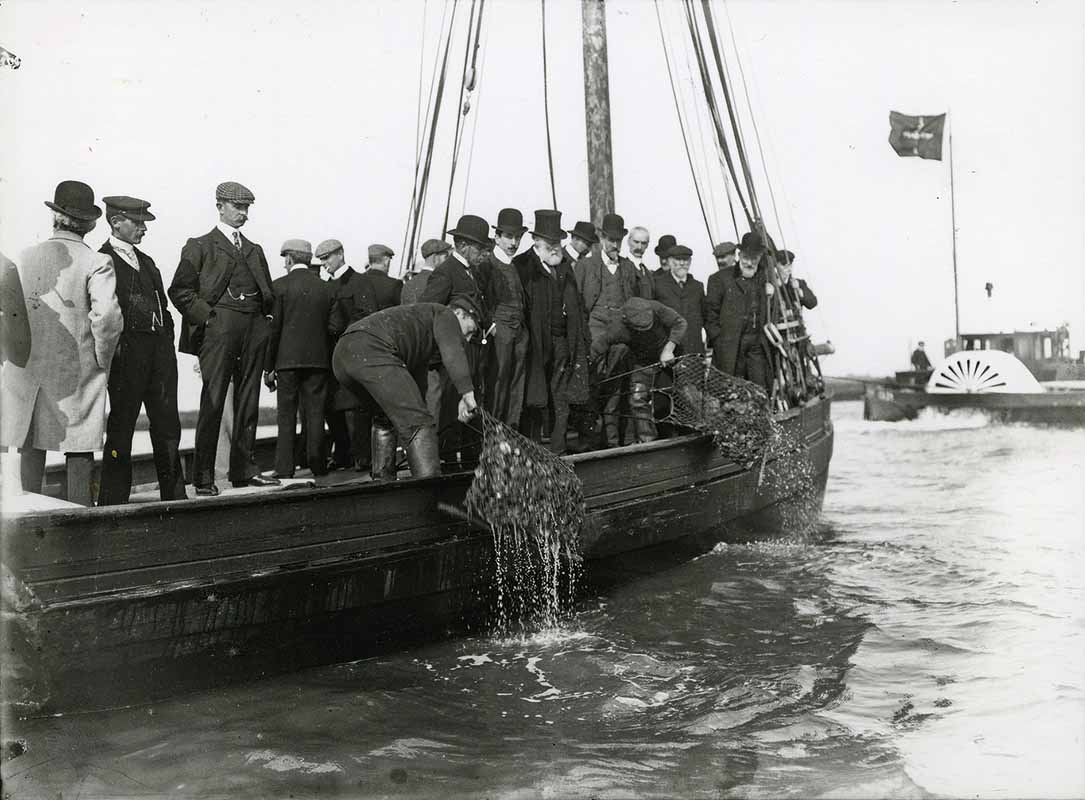
‘Overfishing had been a massive problem and that reduced the ability of the reefs to survive contemporary stresses,’ says Tom Cameron of the University of Essex, an ecologist collaborating with ENORI. ‘It’s a case of multiple stresses swirling together over time.’ One such stress was introduced during the 1980s – the anti-fouling paint tributyltin, which leached from the underside of boats and poisoned the nearby aquatic life.
‘As a boy, I used to go around picking up little oysters and selling them to the merchants of the Mersea waterfront,’ says local oysterman Allan Bird as he stoops to collect a handful of escaped shells. ‘When I got a job in the Mersea oyster industry, all these old boys gave me information about oyster culture, which I soaked up like a sponge.’ His boots collect fragments of shell, seaweed and shingle, which scrape against the rusted metal decking of the restoration boat. ‘As time went on, the Essex stocks went down. To keep the trade alive, I started to bring oysters in from the Solent and Cornwall.’ Things changed in 1983 with the arrival of bonamiosis, a disease caused by the Bonamia parasite, introduced with re-stocks of imported European and US oysters. After that, many oystermen departed the industry, unable to revive the diseased reefs.
The waves at the shore ebb into the surrounding marsh, where a lone godwit wades. ‘Mersea oyster culture wasn’t all about the money; it was about the tradition. It was about the quality of this habitat – you had to look after it, that was our way,’ adds Bird.
Nevertheless, over the years, a local culture of stewardship began to be supplanted by larger commercial operations. With stresses accumulating, many oyster reefs disappeared and the coastal oyster culture began to follow. ‘There were all sorts of things brought into this estuary: American slipper limpets, American tingle [a type of predatory whelk]. It wasn’t quite that same traditional culture,’ says Bird as he rolls a shell between weathered hands.
Oyster reefs in decline
Today, oyster reefs are the most severely threatened marine habitat in the world. A global study has estimated that across 144 bays and 44 of the world’s ecoregions, 85 per cent of oyster reefs have been lost. Many regions of the UK claim just one per cent of former abundance. The Blackwater, Crouch, Roach and Thames estuaries; the Solent; the Firths of Forth and Clyde in Scotland; Galway Bay in Ireland; Chesapeake Bay, Delaware Bay and the estuaries of New Hampshire in the USA; most of the southern Australian coastline – all are examples of areas that have seen oyster numbers plummet.
As a result, the ecosystem services provided by oysters have been largely forgotten. ‘Oyster and shellfish reefs are ecologically equivalent to coral reefs,’ explains Boze Hancock, a marine biologist at the Nature Conservancy and director of the Native Oyster Restoration Alliance (NORA), which includes ENORI in its network. ‘Corals dominate the clean equatorial waters of the tropics, but as you move further towards the poles, into estuaries and in lower latitudes, the shellfish take over.’
‘Oysters build big, three-dimensional reefs that support the marine ecosystem,’ adds Hancock. ‘An average oyster filters 200 litres of water a day and while it’s thought the figure for European native oysters is less than this, hectares of oyster reefs still remove many tonnes of suspended sediment per year, allowing light to penetrate deeper from the surface. This, in turn, allows seagrasses and other organisms to flourish.’
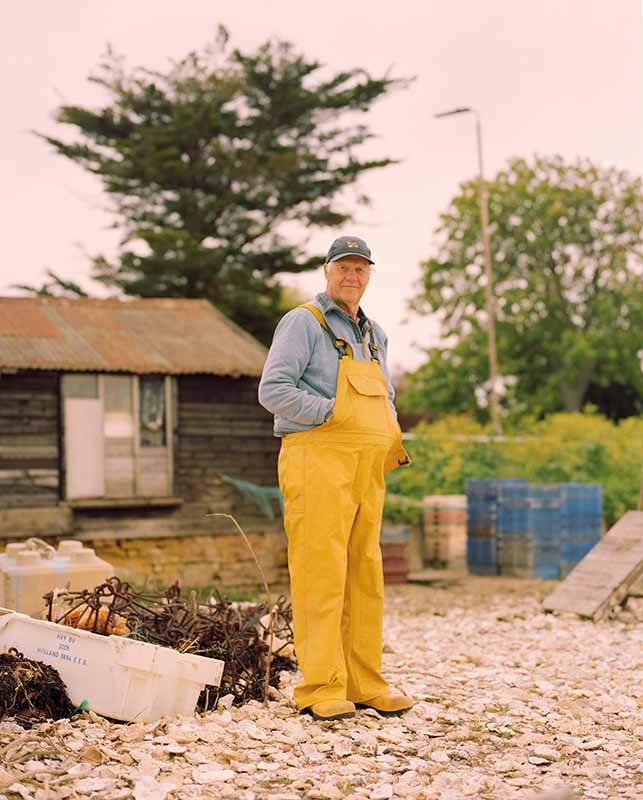
Take away oysters and these clean-up facilities are diminished. Often, where oyster reefs have been overfished, run-off containing nitrogen-based fertilisers has then fed phytoplankton blooms that occlude oxygen from the water beneath. ‘On the north-east coast of the USA, 60 per cent of bays and estuaries are plagued by eutrophication. Wherever phytoplankton are unchecked, depleted fish stocks and “dead zones” lurk beneath,’ says Hancock. In Chesapeake Bay, where native oyster beds are at an estimated one per cent of former abundance, excess nitrogen has polluted the waters since the 1930s, bringing spiralling losses to local fisheries.
A similar scenario has occurred in the waters of the Solent – the 20-mile strait between the Isle of Wight and the UK mainland. In the late 1970s, oyster catches there peaked at 840 tonnes. Since then, there has been a continual, catastrophic decline in their numbers; the Association of Inshore Fisheries and Conservation Authorities reported in 2013 that annual harvests had dropped from 200 to 20 tonnes over five years. The harbours and estuaries at Langstone, Chichester, Portsmouth, Pagham, Medina, Newtown, Eastern Yar and Hamble are now all considered by the Environment Agency to be eutrophic or at risk of eutrophication, and many have been designated as ‘polluted waters’ under the Nitrates Directive. Known to facilitate the ‘denitrification’ of coastal sediments, re-establishing oysters could be one way to mitigate excessive nitrogen levels.
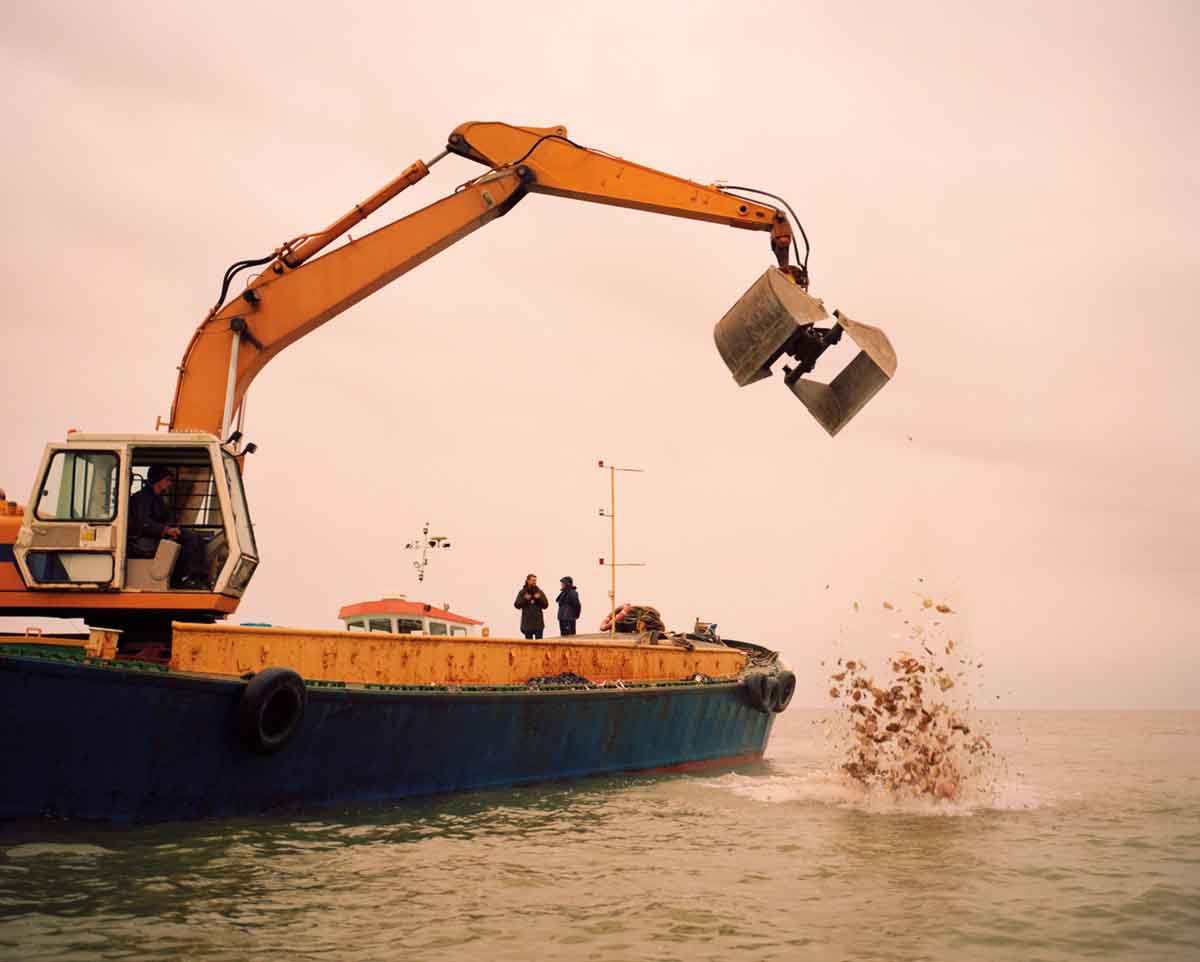
Perhaps the most crucial role of all is the oyster’s provision of habitat for other marine life. ‘Their cryptic surface provides protection for juvenile fish and crustaceans – a critical nursery ground for ocean productivity,’ says Hancock. One 2016 study in the South and mid-Atlantic oceans found that juvenile kingfish, flounder, sea bass, drums and striped bass were all more abundant on oyster habitats relative to the unstructured seabed found in many coastal regions today. Anemones, crabs, queen scallops and clams all contribute to the ‘living crust’ within an oyster bed. A study conducted in the Blackwater Estuary found that European native oysters boosted species richness by 87 per cent.
No wonder, then, that their loss across the world has coincided with a decline in global ocean productivity. ‘When one species goes down, it takes others with it that in turn affect the animals and plants with which they are connected,’ writes leading fisheries expert and marine biologist Callum Roberts in his book Ocean of Life. ‘The more different stresses we add to the blend, the wider the spectrum of life that is directly affected, so the consequences penetrate further through the tangle of existence.’
Shifting baselines
Many marine biologists believe that the loss of oyster reefs is a prime example of ‘shifting baseline syndrome’ – a term that describes the process by which our standards for healthy, functioning ecosystems wane with each passing generation.
‘Shifting baseline syndrome applies to so many things that we don’t recognise on a daily basis. People no longer realise how important an oyster reef was and should be,’ says Hancock. ‘Essentially, every time a dredge or trawl net is set, it reduces the capacity of the ocean to provide the next generation of fish. When the habitat is gone, both the oysters and the fish catches collapse.’
‘Shifting baseline syndrome is an inter-generational amnesia,’ adds world fisheries expert Daniel Pauly. ‘We forget and mistrust the experiences of those living a few generations ago. We don’t trust accounts as much as our own individual perceptions and experiences; we believe merely in what we have seen, in shorter windows of time and change.’
There’s a growing perception among conservationists that the syndrome affects our views of all the world’s ecosystems. Past profusions of butterflies, greater mammal diversity, more abundant woodland birds, seas teeming with fish; the memory of such former abundance erodes with time, and as a result, the conservation goals of contemporary society lose ambition. ‘This means that what we have to do is construct a past where abundance is estimated, using the data and methods of the modern day, with inputs from witness documents, books and available information,’ says Pauly.
Marine biologist Ruth Thurstan is fascinated by this approach to overcoming shifting baseline syndrome. For much of her career, she has painstakingly sifted through landings reports and disjointed fisheries statistics to construct time series that estimate former coastal abundance. In a study published in Nature, she demonstrated that, due to the damaging effects of dredging and trawling, which remove crucial habitat for juveniles, landings of individual fish species from the North Sea have fallen by an average of 94 per cent since 1889. Today, the UK’s fishing fleet lands just one-17th of 19th-century catches.

‘Some of the changes we’ve made to marine ecosystems historically are potentially irreversible, but I don’t see that as a reason not to engage with the historical records and data, and not to use those to become more ambitious in conservation and in fisheries management,’ says Thurstan. ‘In so many places, three-dimensional, living hardshell reefs have been changed to this alternative state dominated by muddy, soft sediment. The knowledge that there were once huge native oyster reefs should enliven our ambition.’
By recognising this former ecosystem abundance, and not dismissing reports as the quixotic ideals of environmentalists, Thurstan, Roberts and Pauly, along with those at ENORI, believe that our expectations of ocean productivity can be raised. ‘These places are forces to consider the scale and ambition at which we, as a society, need to re-examine what marine ecosystems should really look like, and whether we are willing to effect real change,’ says Thurstan.
The restoration antidote
With the cascade of shells drawing to a close, the team of marine biologists and oystermen descend from the restoration boat into nimbler taxi vessels. They haul towards the jetty at West Mersea, weaving between sail boats and barges, evading the shallows of the marsh.
Mersea has been selected as a prime site for oyster reef restoration: there is good documentation of how abundant native oyster reefs used to be and fragments of them persist around the marshland today, thanks to the stewardship of some local oystermen. The biologists and oystermen believe that these remaining reefs will export larvae into the water, ready to settle on the shell- substrate habitats now being created. Tom Cameron of the University of Essex grips the helm, buffeted by the day’s downpour. ‘A female oyster can release hundreds of millions of larvae, and can, in theory, recover a whole population,’ he says, stooping to be heard over the roar of the engine. ‘We’re now building back the structure for those larvae to settle on and increase the chances of reproductive success.’ Herein lies a paradigm for ecosystem restoration in a modern, fragmented world. ‘In ecology, it’s the habitat that determines the carrying capacity of the population. That idea applies here in Mersea, in Dornoch, the Solent; it applies to any environment where lost populations are being revived. Even if you’re talking about headline-grabbing wolf or lynx reintroductions, the habitat must be regenerated first.’
ENORI has nine days of this laborious restoration work planned, come rain or shine. The old oyster beds, still visible on the shore at West Mersea, lie as relics of their former abundance. Over the years, countless oystermen have lugged their fishing gear across this remnant raft of shells. Trailed by the biologists, Bird’s boots crunch across the same surface, weary from a day of restoration. ‘For years, I worked on these grounds and realised that if you can look after the seabed you can get really amazing oysters, which do wonders for the waters,’ he says. ‘They’re black and white, these scientists, but there’s a shared vision here and it’s all about the habitat. Us oystermen need to get together with the scientists. Our traditional knowledge – when backed by science – can be really strong.’
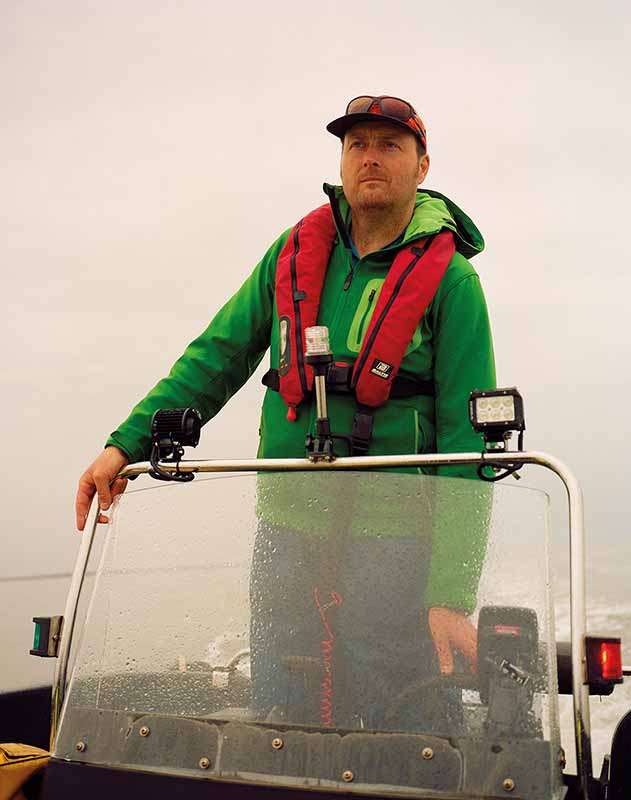
Similar oyster reef restoration initiatives are now popping up around the world. In Scotland, the DEEP project is restoring the oyster beds of the Dornoch Firth, having reintroduced their first oyster in 2017; the Solent Oyster Restoration Project has been installing cages of oyster shells across 12 restoration sites since 2017, and studies show that 97 species now associate with these ‘oyster larvae pumps’; while the ecological and economic basis for oyster reef restoration has been carved out by trailblazing projects across the USA. ‘We’re now at the point in Mersea where we’re starting to collect data that can be brought to funding bodies to get other restoration projects off the ground, just as they have done in the USA,’ says Alison Debney of the Zoological Society of London, one of ENORI’s project managers.
Quantitative studies in Chesapeake Bay show that, by unlocking the nutrients of the sea through waste deposition, restored oyster habitat is worth US$5,342 per hectare annually. In the south-eastern USA, each hectare of restored oyster habitat supports an additional 2.6 tonnes of fish biomass, which is exported out to neighbouring fisheries. ‘Because of the mortality rate of baby fish, if you change the survival rate by just five per cent through the restoration of key habitats such as oyster reefs, you’ve got potentially two or three times the fish at the next life stage,’ says Hancock. Marine biologists believe that by exporting more juvenile fish to neighbouring ‘take zones’, where fishing is allowed, restoration initiatives can quickly pay off any debts incurred. The Chesapeake restoration of 142 hectares of oyster reefs cost US$53 million, yet it generates US$23 million a year in extra fish catch.
Ecosystem restoration, both marine and terrestrial, is increasingly being seen as a tool for local and national economies. The landmark Dasgupta Review on the Economics of Biodiversity, commissioned by the UK Treasury and published last year, argued that the ‘flow’ of ecosystem services translates to monetary value. Hence, the authors argued, the economy’s health is inextricably linked to that of the ecosystems that sustain it. When the British seabed thrives, the ecosystem stores more carbon, filters more nitrogen and toxins from the water, unlocks more nutrients and provides more complex habitat for juveniles of commercially harvested fish and crustaceans.
A new deal for marine ecosystems
Global ocean productivity is in decline. The Sea Around Us Project and the UN Food and Agriculture Organization both report that the number of collapsed fish populations has steadily increased year-on-year, and that by the mid-1990s, 20 per cent of populations that were exploited in the 1950s had collapsed. Across the world, the marine trophic index is declining, indicating that smaller, weaker fish and invertebrates are being caught further down the ocean’s food web. The 2021 Oceana Report states that 28.7 per cent of UK stocks are officially overfished, rising to 33 per cent in the English Channel and 36 per cent in the North Sea.
Given the state of our oceans, many see active habitat restoration and protection as one of the few remaining options to forge a more sustainable relationship with the seas. ‘What we need in times of great planetary stress is a vibrant biosphere,’ writes Roberts in Ocean of Life.
Those at NORA and ENORI, backed by a growing majority of fisheries scientists, ask that we take stock of past ecosystems and raise our ambitions by setting aside more protected areas and designating more sites for active restoration of habitats. This, they say, is a way to overcome shifting baseline syndrome, to recognise what marine ecosystems should really look like and safeguard the future of fishing for coastal communities.
Back on the shore, a ray of sunlight begins to poke through the veil of cloud, casting a faint glow on the old Mersea oyster beds. The tide will soon clothe this historic beach of shells in water and their vast numbers will be obscured for the night. When morning returns, the team of biologists and oystermen will board their restoration crafts for another day on the water. If their vision of vast, restored reefs is realised, who knows how far these life-giving shells may extend around the coast, and what burst of life may again rise up from the deep.




